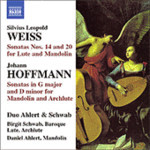
WEISS: Lute Sonatas Nos. 14 & 20 / HOFFMAN: Mandolin Sonata in G major / Mandolin Sonata in D minor
 $25.00
Out of Stock
$25.00
Out of Stock6+ weeks add to cart
WEISS / HOFFMAN
WEISS: Lute Sonatas Nos. 14 & 20 / HOFFMAN: Mandolin Sonata in G major / Mandolin Sonata in D minor
Ahlert & Schwab Duo
[ Naxos / CD ]
Release Date: Sunday 15 April 2007
This item is currently out of stock. It may take 6 or more weeks to obtain from when you place your order as this is a specialist product.
The German lutenist Silvius Leopold Weiss and the Viennese mandolinist Johann Hoffmann were considered the greatest virtuosos of their day in their respective fields.
Silvius Leopold Weiss (1687–1750)
Sonatas for Lute
Born in Breslau in 1687, Weiss was taught the lute by his father, as were his younger brother Johann Sigismund and his youngest sister Juliana Margaretha. After holding various court appointments, he was named Chamber Musician to Augustus the Strong, Elector of Saxony (and king of Poland since 1697) on 23 August, 1718. He was the highest-paid musican at the Dresden court, where he counted the flautist Johann Joachim Quantz and the violinists Francesco Veracini, Franz Benda and Johann Georg Pisendel among his colleagues.
Weiss was also acquainted with Johann Sebastian Bach. It is thought that some of Bach's lute pieces were composed for Weiss. J.F. Reichardt (1805) documents a meeting of the two great musicians: "Anyone who knows the difficulty on the lute of harmonic twists and counterpoint must be amazed, even incredulous, when those who were present and heard with their own ears assure us that the great Dresden lutenist Weisse competed in improvisation and elaborated fugue themes with Sebastian Bach, who was also a great master of the keyboard and the organ."
Silvius Leopold Weiss and Chamber Music
The sonatas and suites from Weiss's pen are now an established part of the lute repertoire. His chamber music is less well-known, on account of its mostly incomplete state. Sometimes the intended scorings are clear, but only the lute parts survive. The pieces recorded here (from a manuscript in the British Library) do not even have indications of scoring. The idea of performing them with mandolin was inspired by Weiss's free treatment of some of his own works; one existed, for example, in versions for two lutes and for lute and flute. It is also very probable that Weiss would have encountered mandolin players among his many Italian colleagues in Dresden.
---
Johann Hoffmann (1770–c.1814)
Sonatas for Mandolin
Little is known about the life and works of the Viennese mandolin player and composer Johann Hoffmann. His works were only re-disseminated in the mid-twentieth century; the originals are still to be found in Viennese libraries. They all involve the mandolin, and require great virtuosity. Their treatment of the instrument, its arpeggios and multiple stops is highly idiomatic.
The Mandolin in Vienna
Around 1800, the six-course mandolin experienced a renaissance in cultivated Viennese circles, and numerous now-forgotten composers left a large repertoire for the instrument. It includes sonatas for mandolin and bass instrument, concertos, and especially duos, trios and quartets with various combinations of strings. This music was well-adapted to the taste of the period, and can be quite impressive in its melodious, elegant simplicity.
Hoffmann can be counted among the most important of this generation of composers. The extreme difficulty of his sonatas shows that he must have been an outstanding instrumentalist. Those recorded here are for "mandolin and bass". The writing of the bass-lines points to the cello as first choice for the accompaniment. There are other similar works, however, that name a bass instrument; in the quartets of Giovanni Francesco Giuliani (ca. 1760 - ca. 1818) a lute can be substituted for the cello, and Giuliani specifically requires the archlute for some pieces. Indeed, this music best unfolds its particular charm with accompaniment by the archlute.
Birgit Schwab and Daniel Ahlert
English version by Glen Wilson
Tracks:
Lute Sonata No. 14 in G minor (Weiss)
Lute Sonata No. 20 in D minor (Weiss)
Mandolin Sonata in D minor (Hoffman)
Mandolin Sonata in G major (Hoffman)
